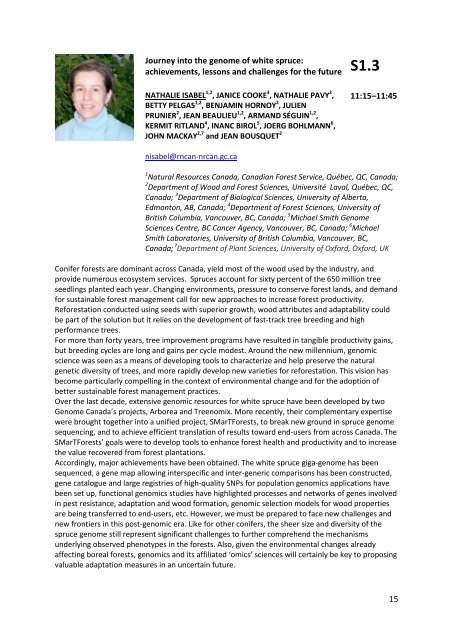Create successful ePaper yourself
Turn your PDF publications into a flip-book with our unique Google optimized e-Paper software.
Journey into the genome of white spruce:<br />
achievements, lessons and challenges for the future<br />
S1.3<br />
NATHALIE ISABEL 1,2 , JANICE COOKE 3 , NATHALIE PAVY 2 , 11:15–11:45<br />
BETTY PELGAS 1,2 , BENJAMIN HORNOY 2 , JULIEN<br />
PRUNIER 2 , JEAN BEAULIEU 1,2 , ARMAND SÉGUIN 1,2 ,<br />
KERMIT RITLAND 4 , INANC BIROL 5 , JOERG BOHLMANN 6 ,<br />
JOHN MACKAY 2,7 and JEAN BOUSQUET 2<br />
nisabel@rncan-nrcan.gc.ca<br />
1 Natural Resources Canada, Canadian Forest Service, Québec, QC, Canada;<br />
2 Department of Wood and Forest Sciences, Université Laval, Québec, QC,<br />
Canada; 3 Department of Biological Sciences, University of Alberta,<br />
Edmonton, AB, Canada; 4 Department of Forest Sciences, University of<br />
British Columbia, Vancouver, BC, Canada; 5 Michael Smith Genome<br />
Sciences Centre, BC Cancer Agency, Vancouver, BC, Canada; 6 Michael<br />
Smith Laboratories, University of British Columbia, Vancouver, BC,<br />
Canada; 7 Department of Plant Sciences, University of Oxford, Oxford, UK<br />
Conifer forests are dominant across Canada, yield most of the wood used by the industry, and<br />
provide numerous ecosystem services. Spruces account for sixty percent of the 650 million tree<br />
seedlings planted each year. Changing environments, pressure to conserve forest lands, and demand<br />
for sustainable forest management call for new approaches to increase forest productivity.<br />
Reforestation conducted using seeds with superior growth, wood attributes and adaptability could<br />
be part of the solution but it relies on the development of fast-track tree breeding and high<br />
performance trees.<br />
For more than forty years, tree improvement programs have resulted in tangible productivity gains,<br />
but breeding cycles are long and gains per cycle modest. Around the new millennium, genomic<br />
science was seen as a means of developing tools to characterize and help preserve the natural<br />
genetic diversity of trees, and more rapidly develop new varieties for reforestation. This vision has<br />
become particularly compelling in the context of environmental change and for the adoption of<br />
better sustainable forest management practices.<br />
Over the last decade, extensive genomic resources for white spruce have been developed by two<br />
Genome Canada’s projects, Arborea and Treenomix. More recently, their complementary expertise<br />
were brought together into a unified project, SMarTForests, to break new ground in spruce genome<br />
sequencing, and to achieve efficient translation of results toward end-users from across Canada. The<br />
SMarTForests’ goals were to develop tools to enhance forest health and productivity and to increase<br />
the value recovered from forest plantations.<br />
Accordingly, major achievements have been obtained. The white spruce giga-genome has been<br />
sequenced, a gene map allowing interspecific and inter-generic comparisons has been constructed,<br />
gene catalogue and large registries of high-quality SNPs for population genomics applications have<br />
been set up, functional genomics studies have highlighted processes and networks of genes involved<br />
in pest resistance, adaptation and wood formation, genomic selection models for wood properties<br />
are being transferred to end-users, etc. However, we must be prepared to face new challenges and<br />
new frontiers in this post-genomic era. Like for other conifers, the sheer size and diversity of the<br />
spruce genome still represent significant challenges to further comprehend the mechanisms<br />
underlying observed phenotypes in the forests. Also, given the environmental changes already<br />
affecting boreal forests, genomics and its affiliated ‘omics’ sciences will certainly be key to proposing<br />
valuable adaptation measures in an uncertain future.<br />
15



